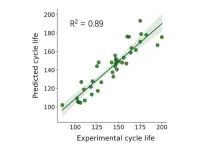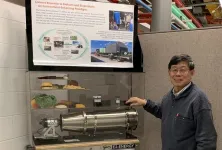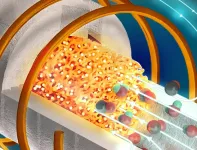(Press-News.org) We know that quality sleep is as essential to survival as food and water. Yet, despite spending a third of our lives in slumber, it largely remains a scientific mystery.
Not that experts haven’t tried.
Sleep analysis, also known as polysomnography, is used to diagnose sleep disorders by recording multiple types of data, including brain (electroencephalogram or EEG) and heart (electrocardiogram or ECG). Typically, patients are hooked up to dozens of sensors and wires in a clinic, tracking brain, eye, muscle, breathing, and heart activity while sleeping. Not exactly Zzz-inducing.
But what if you could perform the same test at home, just as accurately and in real time?
For the first time, computer science researchers at the University of Southern California have developed an approach that matches the performance of expert-scored polysomnography using just a single-lead echocardiogram. The software, which is open-source, allows anyone with basic coding experience to create their own low-cost, DIY sleep-tracking device.
“Researchers have been trying for decades to find simpler and cheaper methods to monitor sleep‚ especially without the awkward cap,” said lead author Adam Jones, who recently earned his PhD from USC. “But so far, the poor performance, even in ideal conditions, has led to the conclusion that it won’t be possible and that measuring brain activity is necessary. Our research shows that this assumption is no longer true.”
The model, which assesses sleep stages at the highest level, also significantly outperformed other EEG-less models, said the researchers, including commercial sleep-tracking devices. “We wanted to develop a system that addresses the limitations of current methods and the need for more accessibility and affordability in sleep analysis,” said Jones.
The study, published June 2024 in the journal Computers in Biology and Medicine, was co-authored by Laurent Itti, a professor of computer science and Jones’ advisor, and Jones’ longtime collaborator, Bhavin R. Sheth, a USC alumnus and electrical engineer at the University of Houston.
Could the heart be leading the band?
Sleep, a key cognitive decline predictor, becomes shorter and more fragmented with age—a finding validated by both previous studies and the researchers’ neural network. But this decline happens earlier than you might expect. A recent study in Neurology found that people who have more interrupted sleep in their 30s and 40s are more than twice as likely to have memory problems a decade later.
Chronic poor sleep can also contribute to the accumulation of beta-amyloid plaques, a hallmark of Alzheimer’s disease.
“It’s a little scary,” said Jones, who admits he was formerly in the “sleep when I’m dead” camp before embarking on this research as a hobby project in 2010. “That’s why I want these interventions to come quickly and to make them accessible to as many people as possible. This software could help tease apart what’s happening when we sleep every night.”
The researchers trained their model on a large, diverse dataset of 4,000 recordings from subjects ranging from 5 to 90 years old, using only heart data and a deep-learning neural network. Through trial and error, spanning hundreds of iterations, they found that the automated ECG-only network could score sleep just as well as the “gold standard” polysomnography. It successfully categorized sleep into all five stages, including rapid eye movement (REM), which is essential for memory consolidation and emotional stability, and non-REM sleep, including deep sleep, which is crucial for physical and mental restoration.
In addition to simplifying a typically expensive and cumbersome process, this insight highlights a deeper connection between the heart and the brain than previously understood. It also underscores the role of the autonomic nervous system, which links the brain and heart.
“The heart and the brain are connected in ways that are not well-understood, and this research aims to bridge that gap,” said Jones. “There is a lot of evidence in my paper that, in fact, the heart may be leading the band, as it were.”
The work could also help improve sleep studies in remote populations, helping to shed light on the origins and functions of sleep.
In a follow-up paper currently being prepared, Jones aims to explore further what the network focuses on in the ECG data. “I think there is a lot of information hidden in the heart that we don’t know about yet,” he said.
END
Heart data unlocks sleep secrets
Study reveals new insights into brain-heart connection, brings expert-level sleep studies into the home.
2024-08-20
ELSE PRESS RELEASES FROM THIS DATE:
Development of a model capable of predicting the cycle lives of high-energy-density lithium-metal batteries
2024-08-20
1. NIMS and SoftBank Corp. have jointly developed a model capable of predicting the cycle lives of high-energy-density lithium-metal batteries by applying machine learning methods to battery performance data. The model proved able to accurately estimate batteries’ longevity by analyzing their charge, discharge and voltage relaxation process data without relying on any assumption about specific battery degradation mechanisms. The technique is expected to be useful in improving the safety and reliability of devices powered by lithium-metal batteries.
2. Lithium-metal ...
UVA Engineering Professor’s $600,000 grant set to innovate pediatric brain tumor treatment
2024-08-19
Natasha Sheybani, assistant professor of biomedical engineering at the University of Virginia School of Engineering, will collaborate with researchers at Children’s National Hospital to study the combination of two therapies for pediatric brain cancer.
High-risk brain tumors in children often don’t respond well to existing chemotherapy and radiation treatments, but Sheybani and her collaborators hope their fusion of therapies will offer a better option.
Over the two-year project, researchers ...
Illinois researchers develop index to quantify circular bioeconomy
2024-08-19
URBANA, Ill. – As the world faces the challenges of mitigating climate change and providing resources for a growing population, there is increasing focus on developing circular economies for sustainable production. But to evaluate strategies and impacts, it is necessary to have reliable metrics. Researchers at the University of Illinois Urbana-Champaign have developed a Circularity Index that provides a comprehensive method to quantify circularity in bioeconomic systems. In a new paper, they outline the method and apply it to two case studies – a corn/soybean farming operation and the entire U.S. food and agriculture system.
“The ...
Less severe forest fires can reduce intensity of future blazes
2024-08-19
Not all forest fires have devastating effects. Low- and moderate-severity forest wildfires can reduce the intensity of future conflagrations for as long as 20 years in certain climates, according to new research by the University of California, Davis.
The extent of reduced severity of these second fires, or reburns, and the duration of the moderating effect, varies by climate, forest type and other factors. But initial fires continue to mitigate future severity even during extreme weather, such as wind, high temperatures and drought, research published in the journal Ecological ...
Electric reactor could cut industrial emissions
2024-08-19
Currently, industrial processes in the U.S. account for approximately a third of the country’s carbon dioxide emissions – even more than the annual emissions from passenger vehicles, trucks, and airplanes combined. Decarbonizing this sector is a challenging but vital step in mitigating impacts on our future climate.
Researchers at Stanford Engineering have designed and demonstrated a new type of thermochemical reactor that is capable of generating the immense amounts of heat required for many industrial processes using electricity instead of burning fossil fuels. The design, published Aug. ...
Causal relationship between PECAM-1 level and cardiovascular diseases
2024-08-19
https://www.scienceopen.com/hosted-document?doi=10.15212/CVIA.2024.0032
Announcing a new article publication for Cardiovascular Innovations and Applications journal. Platelet endothelial cell adhesion molecule (PECAM-1) is present in the vascular endothelium and plays important roles in various biological processes. Several recent studies have reported associations between PECAM-1 and certain subtypes of cardiovascular diseases (CVDs). However, further research is necessary to clarify the causal effects of PECAM-1 on CVDs.
To determine whether PECAM-1 and CVDs are causally ...
The plausible role of vascular adhesion molecules in cardiovascular diseases
2024-08-19
https://www.scienceopen.com/hosted-document?doi=10.15212/CVIA.2024.0046
Announcing a new article publication for Cardiovascular Innovations and Applications journal. Vascular Adhesion Molecules (VAMs) appear to play important roles in the development of Cardiovascular Diseases (CVD). The roles of these molecules in mediating inflammation, endothelial dysfunction, and plaque formation suggest that they may be important as both biomarkers and therapeutic targets. Understanding and targeting these molecules are hoped to substantially contribute to ...
Whole-exome sequencing identifies three novel TTN variants in Chinese families with dilated cardiomyopathy
2024-08-19
https://www.scienceopen.com/hosted-document?doi=10.15212/CVIA.2024.0040
Announcing a new article publication for Cardiovascular Innovations and Applications journal. Dilated cardiomyopathy (DCM), a severe heart disease, is the leading cause of heart failure and sudden cardiac death worldwide. DCM is defined by a dilated and deficient systolic left ventricle (LV) and is a major risk factor for morbidity and mortality worldwide. DCM progression can be ascribed to genetic and non-genetic factors, including hypertension, infectious agents, toxins, and drugs.
Sarcomere genes play crucial roles in myocardial cells’ physical structure and physiological function. Various cardiomyopathies ...
Key biofuel-producing microalga believed to be a single species is actually three
2024-08-19
MEDIA INQUIRES
WRITTEN BY
Laura Muntean
Ashley Vargo
laura.muntean@ag.tamu.edu
601-248-1891
FOR ...
Simple alternative criteria identify people with the most to gain from lung cancer screening
2024-08-19
Embargoed for release until 5:00 p.m. ET on Monday 19 August 2024
Annals of Internal Medicine Tip Sheet
@Annalsofim
Below please find summaries of new articles that will be published in the next issue of Annals of Internal Medicine. The summaries are not intended to substitute for the full articles as a source of information. This information is under strict embargo and by taking it into possession, media representatives ...
LAST 30 PRESS RELEASES:
Tracing the quick synthesis of an industrially important catalyst
New software sheds light on cancer’s hidden genetic networks
UT Health San Antonio awarded $3 million in CPRIT grants to bolster cancer research and prevention efforts in South Texas
Third symposium spotlights global challenge of new contaminants in China’s fight against pollution
From straw to soil harmony: International team reveals how biochar supercharges carbon-smart farming
Myeloma: How AI is redrawing the map of cancer care
Manhattan E. Charurat, Ph.D., MHS invested as the Homer and Martha Gudelsky Distinguished Professor in Medicine at the University of Maryland School of Medicine
Insilico Medicine’s Pharma.AI Q4 Winter Launch Recap: Revolutionizing drug discovery with cutting-edge AI innovations, accelerating the path to pharmaceutical superintelligence
Nanoplastics have diet-dependent impacts on digestive system health
Brain neuron death occurs throughout life and increases with age, a natural human protein drug may halt neuron death in Alzheimer’s disease
SPIE and CLP announce the recipients of the 2025 Advanced Photonics Young Innovator Award
Lessons from the Caldor Fire’s Christmas Valley ‘Miracle’
Ant societies rose by trading individual protection for collective power
Research reveals how ancient viral DNA shapes early embryonic development
A molecular gatekeeper that controls protein synthesis
New ‘cloaking device’ concept to shield sensitive tech from magnetic fields
Researchers show impact of mountain building and climate change on alpine biodiversity
Study models the transition from Neanderthals to modern humans in Europe
University of Phoenix College of Doctoral Studies releases white paper on AI-driven skilling to reduce burnout and restore worker autonomy
AIs fail at the game of visual “telephone”
The levers for a sustainable food system
Potential changes in US homelessness by ending federal support for housing first programs
Vulnerability of large language models to prompt injection when providing medical advice
Researchers develop new system for high-energy-density, long-life, multi-electron transfer bromine-based flow batteries
Ending federal support for housing first programs could increase U.S. homelessness by 5% in one year, new JAMA study finds
New research uncovers molecular ‘safety switch’ shielding cancers from immune attack
Bacteria resisting viral infection can still sink carbon to ocean floor
Younger biological age may increase depression risk in older women during COVID-19
Bharat Innovates 2026 National Basecamp Showcases India’s Most Promising Deep-Tech Ventures
Here’s what determines whether your income level rises or falls
[Press-News.org] Heart data unlocks sleep secretsStudy reveals new insights into brain-heart connection, brings expert-level sleep studies into the home.






